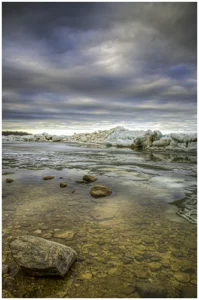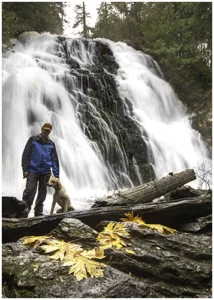
ON1 NoNoise AI Review: Eliminate Noise & Sharpen Your Photos
Are you tired of noise or grain messing up your photos? ON1 NoNoise AI could
Grand Opening & Black Friday Sale = 50% Off


There is a wide selection of lens filters, which one to use can puzzle anyone. But two filters stand out: the neutral density (ND) filter and the polarizing (CPL) filter. They can can help you get more keepers while out an a long day of shooting.
In this guide we’ll discus when and where each one works best and how they can help take your photography further. Understanding these filters helps you take better pictures, no matter if you shoot landscapes, waterfalls, or other subjects.
Photographers use various tools to enhance their photos. What’s the difference between ND and polarizer filters is the key to getting the most out of them.
ND filters reduce the amount of light that enters through the lens, allowing photographers to shoot in bright areas. However they are so much more that that.
A variable ND filter provides simple control over light intake, letting you adjust the filter without overexposing your shot.
This feature proves useful for many photo types, such as smooth clouds or dynamic city scenes.
Polarization filters have a unique effect. They reduce the shine on nonmetallic surfaces, which improves color vibrancy. These filters excel at deepening blue skies, reducing reflections on water, and highlighting details in trees.
They’re essential for outdoor and landscape photography.
ND filters and polarizers make our photos better in different ways.
Both filters attach to your lens and provide distinct benefits. When it comes to lighting control, ND filters shine, especially when you selectively darken certain areas of the image.
Polarizers excel at cutting glare and boosting colours, allowing you to capture clearer, more vibrant images. Understanding these tools can elevate your photography.
| Filter Type | Primary Function | Best Used For |
|---|---|---|
| ND Filter | Light reduction | Long exposures and blurred motion |
| Polarizer (CPL) | Glare reduction | Colour enhancement and reflections control |
Black Friday deals on now! Save up to 77% – Plus an additional 10% when you use code bwild10
ND filters change the amount of light that enters the lens. This allows us to take photos with slower shutter speeds or wider apertures in bright areas. The ND filter’s density determines how much light it blocks.
A CPL filter doesn’t reduce light. Its main job is to eliminate luminosity and control reflections. Polarizing boosts colour vibrancy and sharpens contrasts. That’s why CPL filters work great for landscapes, reducing haze and making clouds pop.
ND filters work best to control exposure. They help to create the silky look in waterfalls or smooth out clouds. ND filters let us take longer exposures, capturing movement in creative ways.
Circular polarizers help colours stand out and handle reflections. They excel when shooting through glass or water. A polarizer gets rid of unwanted luminosity and deepens skies.
| Featured | ND Filter | Polarizer (CPL) |
|---|---|---|
| Primary Function | Reduces light intensity | Eliminates unwanted glare and reflections |
| Effect on Exposure | Allows longer exposures | Minimal effect |
| Color Impact | Neutral | Enhances saturation |
| Best For | Long exposures, motion blur | Reducing reflections, deepening skies |
Filters play a crucial role in landscape photography, transforming ordinary scenes into stunning images. We’ll explore how ND filters and polarizers can improve your photos by altering light and boosting image quality. Know when to use a CPL or ND filter can improve your photography.
ND filters reduce the amount of light entering your camera, allowing for longer exposures in bright conditions. This works well to capture smooth waterfalls or drifting clouds. Motion adds drama to our photographs.
For example, an ND filter on a bright day can slow down your camera’s shutter speed. This technique turns fast-flowing water into a misty appearance, adding a magical by allowing you to capture motion without overexposing.
Polarizers make colors pop and reduce reflections. They’re excellent for snapping pics of plants or vibrant skies. They reduce the glare from reflective surfaces like water, and show more detail. They make colors vibrant by handling reflections and luminosity effectively.
In landscape photography a polarizer can turn a boring sky into a rich blue or reveal rocks beneath a stream. It’s like putting shades on your camera, getting rid of unwanted reflections, and showcasing the beauty of the scene.
Getting the hang of these filters gives us more room to be creative and capture photos that garnish attention.
Filters allow us to play with light, bringing our photos to life, whether we’re capturing flowing water or nature’s vibrant hues.
Knowing the right time to use ND filters or polarizers can transform your photos. Let’s look at some real-world situations where these filters shine.
ND filters come in handy in bright light when you want to slow down your shutter speed without overexposing your image. They’re ideal for smoothing out water or capturing moving objects in motion. An ND filter allows you to use wider apertures in bright light.
Polarizers excel at enhancing the sky and cutting down reflections, allowing you to capture more vivid images. in landscapes they work best when you are 90 degrees to the sun.
| Scenario | ND Filter | Polarizer |
|---|---|---|
| Landscape with blue skies | Not Ideal | Excellent |
| Waterfall in bright sunlight | Excellent | Good |
| City architecture | Good for motion blur | Good for reducing reflections |
| Beach scenes | Good for long exposure | Excellent for enhancing colours |
Try stacking filters together for even more creative control over your photos.
Using ND and polarizer filters at the same time unlocks new ways to be creative. This pair helps you captures photos in tricky light situations. Let’s explore how to get the most out of this strong duo.
When you’re close to shiny surfaces or waterfalls, ND and polarizer filters are a must-haves. Consider using a polarizer to manage reflections and improve color. The ND filter lets you slow down the shutter to create smooth motion blur. Together, they make water look silky, and colors look bright and saturated.
Combining these filters creates new opportunities to showcase your skills in landscape photography. You can snap pictures of drifting clouds against clear blue skies. When shooting seascapes, you can capture the foggy charm of waves and the ocean’s authentic hues. In urban settings, you can slow down vehicle lights while maintaining crisp details of buildings on shiny glass surfaces.
Keep in mind that you’ll need to tweak your camera settings when using both filters together. The light often changes, so you might have to adjust your ISO or aperture. As you gain experience, you’ll learn to balance these filters to bring your artistic vision to life in any lighting condition.
We looked at ND and CPL filters to see how they play special roles in photography. ND filters work well for long exposures and wide-angle shots without overexposure. They’re just right to create dreamy water scenes or capture busy city views.
CPL filters do their best to make colours stand out in leaves or get rid of water reflections. They help show off nature’s true colours.
The filter you pick depends on what you want to shoot and the conditions of the scene. ND filters shine in bright scenes when you want motion blur or to get a shallow depth of field.
CPL filters make colours more vivid and cut down on glare. They’re spot-on to enhance foliage and handle reflections.
Lots of photographers have both filters on hand. Combining ND and CPL gives more room to be creative. This pair helps with tricky lighting in scenes like foggy waterfalls or vibrant autumn landscapes.
No, although both are popular for landscape photography, they target different effects. A neutral density filter reduces light intensity without affecting color, while a polarizing filter reduces glare and enhances contrast by filtering out specific light waves.
The advantage of a neutral density filter is that it reduces light entering the camera without affecting color, allowing for longer exposures or wider apertures in bright conditions. This enables photographers to create motion blur, shallow depth of field, or smooth water effects in daylight.
I carry both, if your doing landscape photography. You will have ample opportunity to use a ND filters to reduce light for long exposures, and a CPL filters to reduce glare and enhance colors.

Are you tired of noise or grain messing up your photos? ON1 NoNoise AI could

Every time I get ready to photograph a waterfall, I feel a rush of excitement.

If you’re looking for an easy hike, well… this hike is not it! Most of